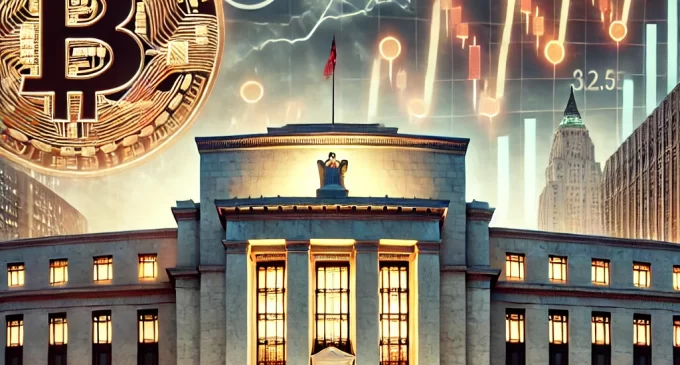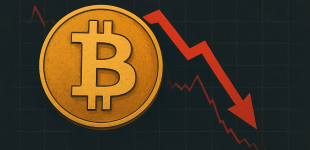
Introduction
The crypto market, a symbol of financial independence and volatility, is once again facing a challenging period. On September 16, 2024, Bitcoin and the broader crypto market experienced a notable slump. The primary reason behind this downturn? A looming decision by the U.S. Federal Reserve regarding potential rate cuts. With economic growth slowing down and inflation still being a concern, all eyes are on the Federal Reserve as it decides how to navigate the financial waters. The uncertainty surrounding this decision has cast a shadow over both traditional and digital markets, especially cryptocurrencies, which are particularly sensitive to macroeconomic factors.
The Influence Of Federal Reserve Decisions On Cryptocurrencies
In 2023 and 2024, the cryptocurrency market saw multiple waves of growth and corrections, with key influencers being global regulatory actions, the adoption of blockchain technology, and macroeconomic factors. Among these, decisions made by the Federal Reserve have had significant ripple effects on digital assets like Bitcoin, Ethereum, and other altcoins.
Interest rates are a central lever for controlling inflation and stimulating or slowing down economic growth. When interest rates rise, borrowing becomes more expensive, potentially cooling down investments, including those in high-risk assets such as cryptocurrencies. On the flip side, when the Fed cuts rates, it typically encourages borrowing and investment. Lower interest rates also make traditional safe havens, such as government bonds, less attractive, potentially driving more interest in alternative assets like Bitcoin. Therefore, the Federal Reserve’s policies have an indirect but profound impact on the price action in the crypto space.
Market Reaction Leading Up To The Decision
As of mid-September 2024, Bitcoin was trading below $60,000, down significantly from its peak earlier in the year. Other major cryptocurrencies, including Ethereum, Solana, and Binance Coin, also experienced notable drops. This collective market slump was driven primarily by uncertainty surrounding the Federal Reserve’s upcoming rate cut decision.
Investors typically shy away from risky assets when uncertainty is high. The volatility in Bitcoin and the overall crypto market can be attributed to several key factors:
Uncertainty about the Federal Reserve’s Decision: The central bank is expected to announce a rate cut, but the size of the cut remains uncertain. The market is split between those expecting a modest 0.25% cut and those predicting a more aggressive 0.50% reduction. This uncertainty has left investors hesitant, with many opting to liquidate their crypto holdings in anticipation of the announcement.
Inflation Concerns: Inflation, though moderated compared to the highs of 2022, remains a concern. The Fed’s primary goal is to balance inflation control with economic growth, but striking this balance has proven difficult. For Bitcoin, often viewed as a hedge against inflation, this uncertainty has also fueled price volatility.
Correlation with Traditional Markets: Historically, Bitcoin and other cryptocurrencies have been viewed as non-correlated assets—meaning their performance was not directly tied to traditional financial markets. However, recent years have shown that crypto prices can follow global financial trends, especially during periods of economic stress. The stock market also faces uncertainty, with major indices like the S&P 500 and NASDAQ fluctuating as investors await the Federal Reserve’s next move. This has amplified the bearish sentiment in the crypto market.
Investor Sentiment And Market Psychology
The broader crypto market is driven largely by sentiment. In times of optimism, assets like Bitcoin can see rapid price increases as FOMO (Fear of Missing Out) takes over. However, in uncertain times, fear can drive panic selling, which is exactly what is unfolding in mid-September 2024.
Data from various exchanges show an increase in sell orders and a decline in trading volumes. While the sell-off hasn’t yet reached the panic levels seen during previous market corrections, it is evident that many retail and institutional investors are treading cautiously. As many wait for clearer guidance from the Federal Reserve, volatility is expected to persist.
Furthermore, the derivatives market has added fuel to the fire. Traders with leveraged positions have been forced to liquidate as prices fell, which has further exacerbated the downward pressure on Bitcoin and other cryptocurrencies.
Potential Outcomes Of The Federal Reserve’s Decision
Modest Rate Cut (0.25%): If the Federal Reserve opts for a smaller rate cut, the immediate reaction in the crypto markets might be muted. While a reduction in rates is generally seen as positive for risky assets, a modest cut might not provide enough stimulus to counteract the current bearish sentiment. Bitcoin might stabilize around its current levels, but significant upward momentum could be lacking.
Aggressive Rate Cut (0.50%): A more aggressive rate cut could inject fresh optimism into the markets. Lower borrowing costs and reduced yields on traditional assets like bonds could make cryptocurrencies more attractive to investors seeking higher returns. Bitcoin and other cryptocurrencies could see a quick recovery, with a potential rally back towards $70,000 in the near term.
No Rate Cut: The worst-case scenario for the crypto market would be if the Federal Reserve decides to keep rates unchanged. Such an outcome would likely result in further downside for Bitcoin and the broader market, as investors adjust to a more prolonged period of tighter financial conditions.
The Long-Term Outlook For Cryptocurrencies
Despite the short-term bearishness, the long-term outlook for Bitcoin and other cryptocurrencies remains robust. Cryptocurrencies have become a core part of the global financial ecosystem, with institutional adoption growing steadily. Major players like BlackRock and Fidelity have continued to explore opportunities in the digital asset space, signaling confidence in the long-term value proposition of cryptocurrencies.
Bitcoin’s halving event in 2024 is another factor that could fuel a new bull run. Historically, Bitcoin halvings—where the reward for mining new blocks is cut in half—have been followed by significant price increases as supply becomes more constrained.
Moreover, advancements in blockchain technology, regulatory clarity, and the rise of decentralized finance (DeFi) are expected to drive further adoption. As traditional financial institutions increasingly integrate blockchain-based solutions, cryptocurrencies could benefit from increased legitimacy and trust.
Conclusion
The current slump in the crypto market is undeniably tied to the uncertainty surrounding the Federal Reserve’s impending rate cut decision. However, while short-term volatility may persist, the long-term fundamentals of Bitcoin and other cryptocurrencies remain strong. Investors are encouraged to brace for potential swings in the coming days, but the broader trajectory for digital assets still points to growth, particularly as institutional adoption deepens and blockchain innovation continues.
Ultimately, the Federal Reserve’s decision will set the tone for both traditional and digital markets in the months ahead. For now, all eyes remain on the central bank as the crypto community awaits clarity.







There are no comments at the moment, do you want to add one?
Write a comment